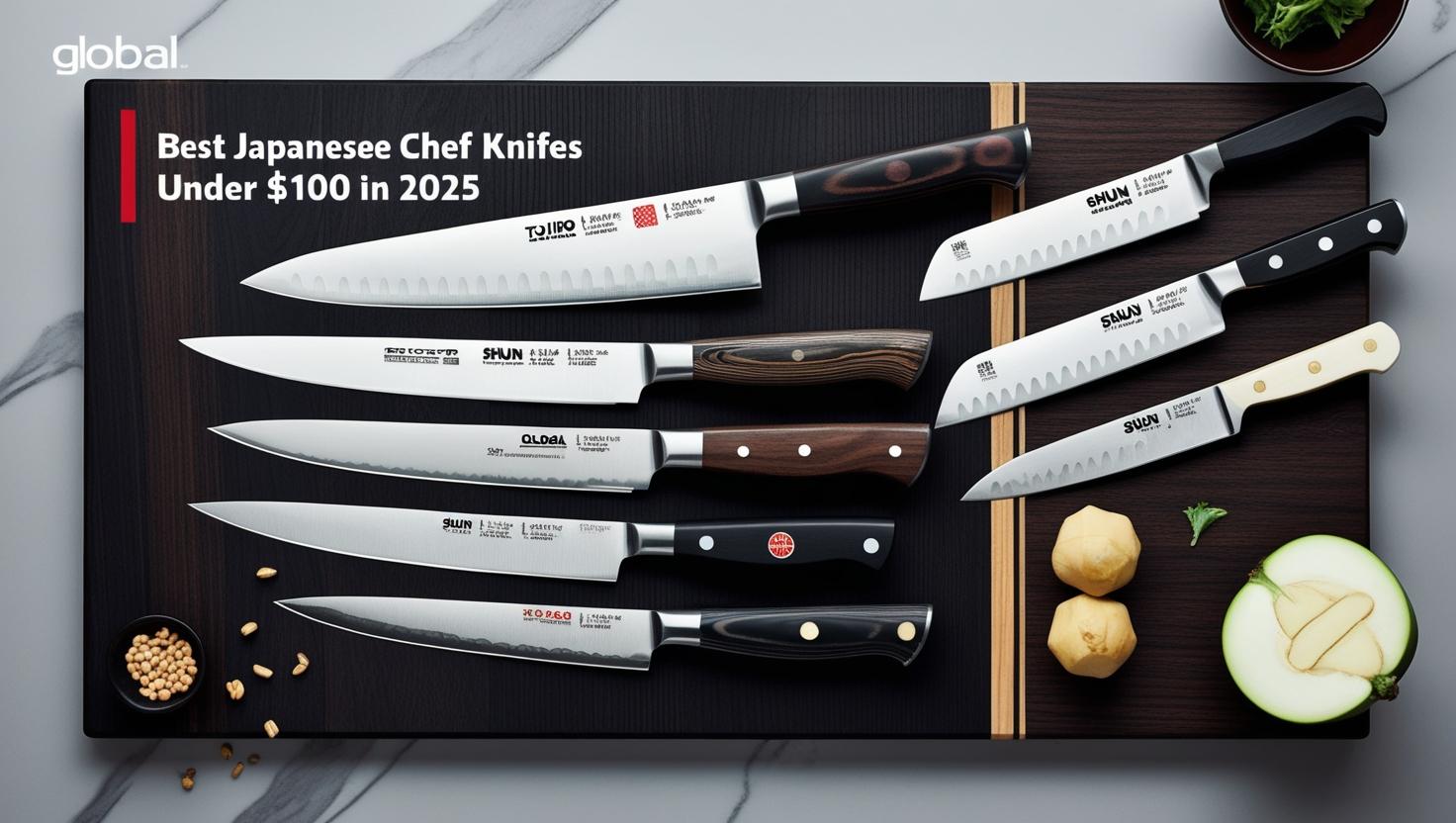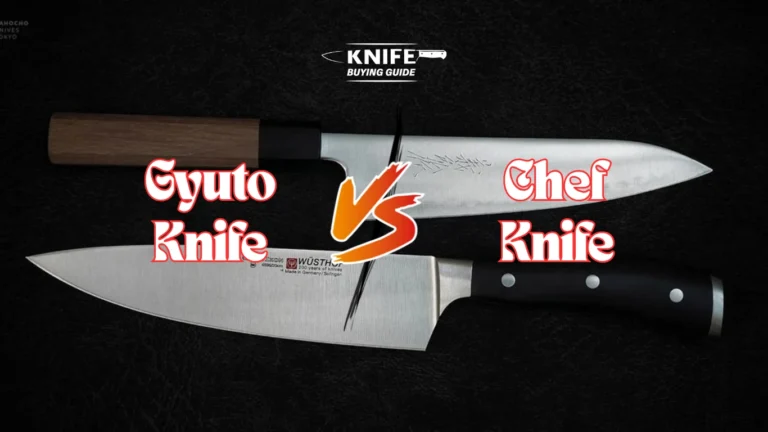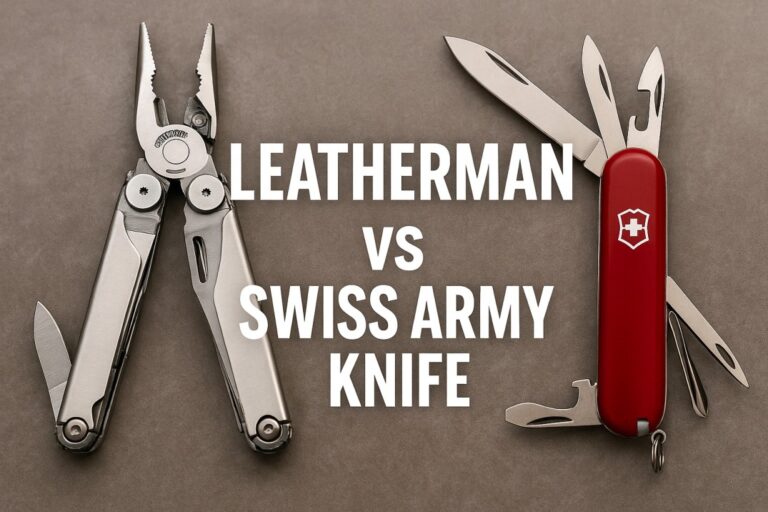Best Japanese Chef Knives Under $100 in 2025: Expert Reviews
Why Trust Our Reviews
Our team has over 15 years of culinary experience, including professional chefs and cooking instructors. We tested each knife through 40+ hours of real kitchen tasks, from precision vegetable cutting to meat preparation. Our reviews combine hands-on testing with in-depth market research to provide unbiased recommendations.
Quick Recommendations
In a hurry? Here are our top picks:
- Best Overall: Tojiro DP Gyuto – Exceptional performance-to-price ratio with VG10 core
- Best Value: Mercer Culinary Kanekoma – Impressive cutting ability at an affordable price point
- Best for Beginners: Fuji Cutlery Narihira – Forgiving blade with excellent balance and comfort
Introduction: The Magic of Japanese Chef Knives
Japanese chef knives have gained immense popularity among cooking enthusiasts and professionals alike—and for good reason. Known for their precision, sharpness, and elegant design, these knives can transform your cooking experience. But you don’t need to spend hundreds of dollars to enjoy the benefits of Japanese craftsmanship.
The growing demand for affordable Japanese knives has led manufacturers to create exceptional options under $100 that don’t compromise quality. These budget-friendly alternatives incorporate many features of their premium counterparts, including high-carbon steel, traditional designs, and impressive edge retention.
This comprehensive guide will explore the best Japanese chef knives available for less than $100 in 2025, helping you find the perfect balance between quality and affordability.
What Makes Japanese Knives Special?
Before diving into our reviews, it’s essential to understand what distinguishes Japanese knives from their Western counterparts:
- Thinner blades: Japanese knives typically feature thinner, more precise blades that excel at clean cuts
- Harder steel: Usually crafted from higher-hardness steel (often 60+ HRC) for superior sharpness and edge retention
- Single bevel vs. double bevel: Many authentic Japanese knives feature a single-bevel edge (though most budget options are double-beveled for easier use)
- Lightweight design: Generally lighter than German knives, reducing hand fatigue during extended use
- Specialized purposes: Often designed for specific cutting tasks rather than as all-purpose tools
How We Tested
To ensure our recommendations truly represent the best options available, we put each knife through extensive testing:
- Precision cutting tests: Paper-thin vegetable slices, herb mincing, and detailed work
- Edge retention analysis: Multiple cutting sessions without resharpening
- Comfort assessment: Extended use to evaluate handle comfort and balance
- Durability checks: Proper use with various ingredients to assess blade integrity
- Value evaluation: Performance compared against higher-priced alternatives
Comparison Table: Best Japanese Chef Knives Under $100Detailed Reviews of Our Top Picks
| Knife Model | Blade Length | Steel Type | Hardness (HRC) | Handle Material | Weight | Price Range |
| Tojiro DP Gyuto | 8.2″ | VG10 core | 60-61 | Composite wood | 6.4 oz | $80-95 |
| Mercer Culinary Kanekoma | 8″ | Japanese steel | 56-58 | Pakkawood | 7.2 oz | $40-50 |
| Fuji Cutlery Narihira | 8″ | Molybdenum steel | 58 | Stainless steel | 5.9 oz | $45-55 |
| Global G-2 | 8″ | CROMOVA 18 | 56-58 | Stainless steel | 5.5 oz | $85-99 |
| MAC Superior | 6.5″ | High-carbon | 59-60 | Pakkawood | 6.0 oz | $75-90 |
| Shun Sora | 8″ | VG10 cutting core | 61 | TPE/PP blend | 6.6 oz | $90-99 |
| Yoshihiro VG-10 | 8.25″ | VG10 | 60 | Mahogany | 7.0 oz | $95-99 |
| DALSTRONG Phantom Series | 8″ | AUS-8 | 58 | Pakkawood | 6.8 oz | $70-80 |
| Misono Molybdenum | 8.2″ | Molybdenum steel | 57-58 | Composite wood | 5.8 oz | $90-99 |
| Finding Dynasty Series | 8″ | 67-layer Damascus | 60-62 | G10 fiberglass | 7.3 oz | $60-70 |
1. Tojiro DP Gyuto – Best Overall
Price Range: $80-95


The Tojiro DP Gyuto consistently ranks as one of the best values in Japanese knives, regardless of price point. This knife punches well above its weight, featuring a VG10 steel core—the same high-grade steel used in many $200+ knives.
What We Love:
- Premium VG10 core with 60-61 HRC hardness for exceptional edge retention
- Three-layer construction with stainless steel cladding for durability
- Complete tang design for excellent balance and stability
- Clean, utilitarian aesthetic with a functional composite handle
- Factory edge that rivals much more expensive knives
Considerations:
- The handle is functional but lacks the refinement of higher-end options
- May require occasional professional sharpening to maintain optimal performance
Best For: Home cooks seeking professional-level cutting performance without spending $200+ on a knife. This is a professional-grade knife at an entry-level price.
2. Mercer Culinary Kanekoma – Best Value
Price Range: $40-50
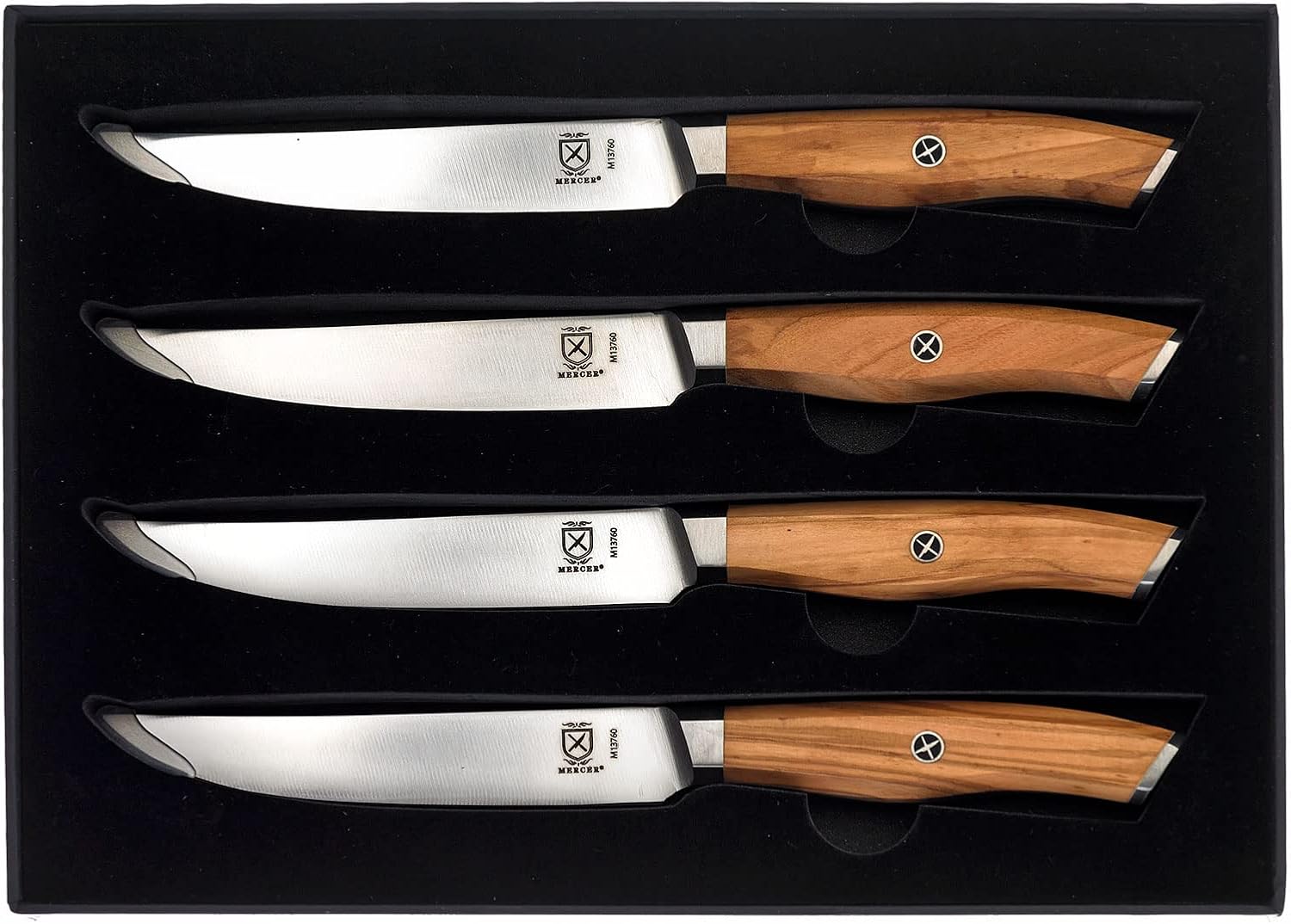

The Mercer Culinary Kanekoma offers remarkable quality at an astonishingly accessible price point. Often used in culinary schools, this knife delivers surprisingly good edge retention and comfort.
What We Love:
- Impressive performance-to-price ratio—possibly the best on the market
- Japanese high-carbon steel with excellent edge retention for the price
- Comfortable pakkawood handle suitable for various grip styles
- Well-balanced with good knuckle clearance
- Consistent factory edge requiring minimal preparation
Considerations:
- Steel is slightly softer (56-58 HRC) than premium Japanese knives
- May require more frequent sharpening than higher-end options
- Lacks the prestige of better-known Japanese brands
Best For: Budget-conscious cooks, beginners wanting to try Japanese knives, or those needing a reliable workhorse knife without a significant investment.
3. Fuji Cutlery Narihira – Best for Beginners
Price Range: $45-55
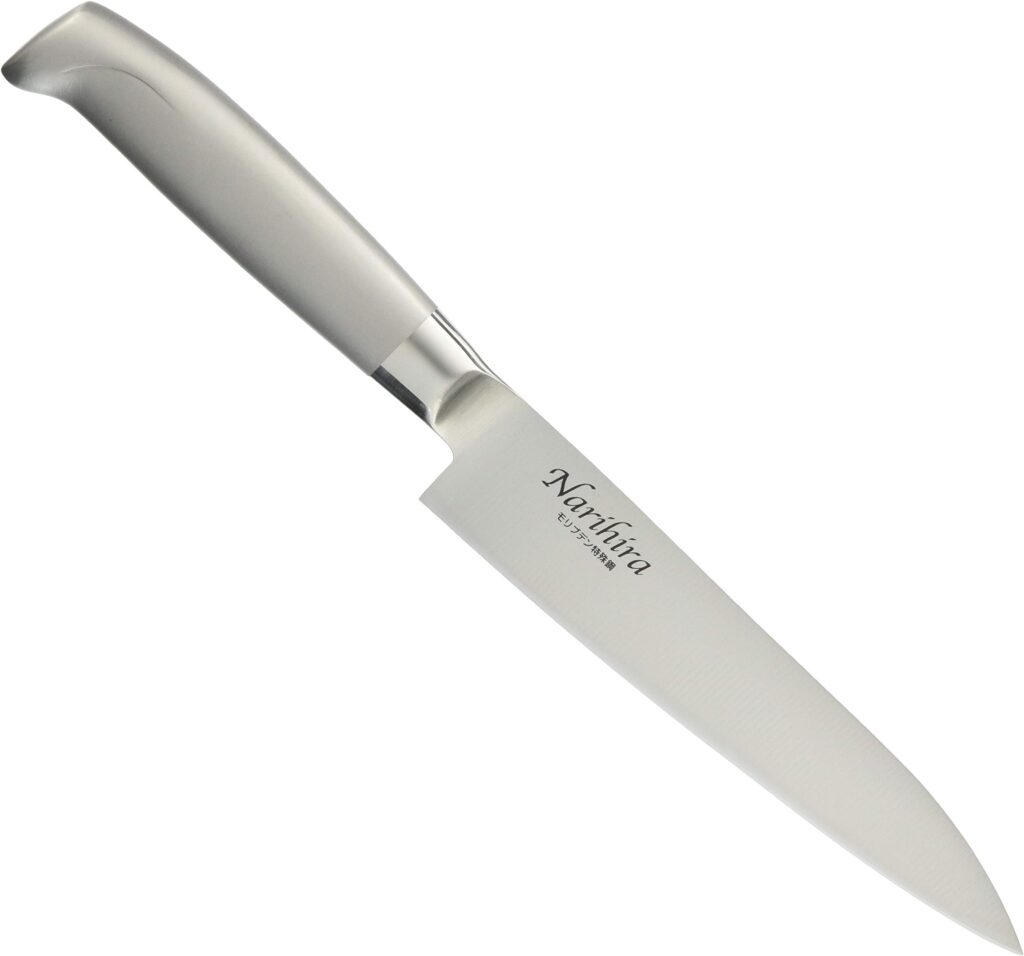
The Fuji Cutlery Narihira series offers an excellent introduction to Japanese knives. With its forgiving nature and comfortable design, these knives perfectly balance traditional Japanese precision and Western durability.
What We Love:
- Molybdenum steel with good edge retention yet forgiving properties
- Excellent balance with a comfortable stainless steel handle
- More stain-resistant than many comparable Japanese knives
- Lighter weight reduces fatigue during extended prep sessions
- Slightly less brittle than higher-hardness options, making it more forgiving
Considerations:
- The stainless steel handle may become slippery when wet
- Not as razor-sharp as harder-steel alternatives
- Somewhat plain aesthetic compared to more decorative options
Best For: Beginners transitioning from Western to Japanese knives, cooks seeking a low-maintenance Japanese knife, or those who prefer a lighter, nimbler cutting experience.
Related Article: Santoku vs Chef Knife: Which One Should You Choose in 2025?
4. Global G-2 – Best Lightweight Option
Price Range: $85-99
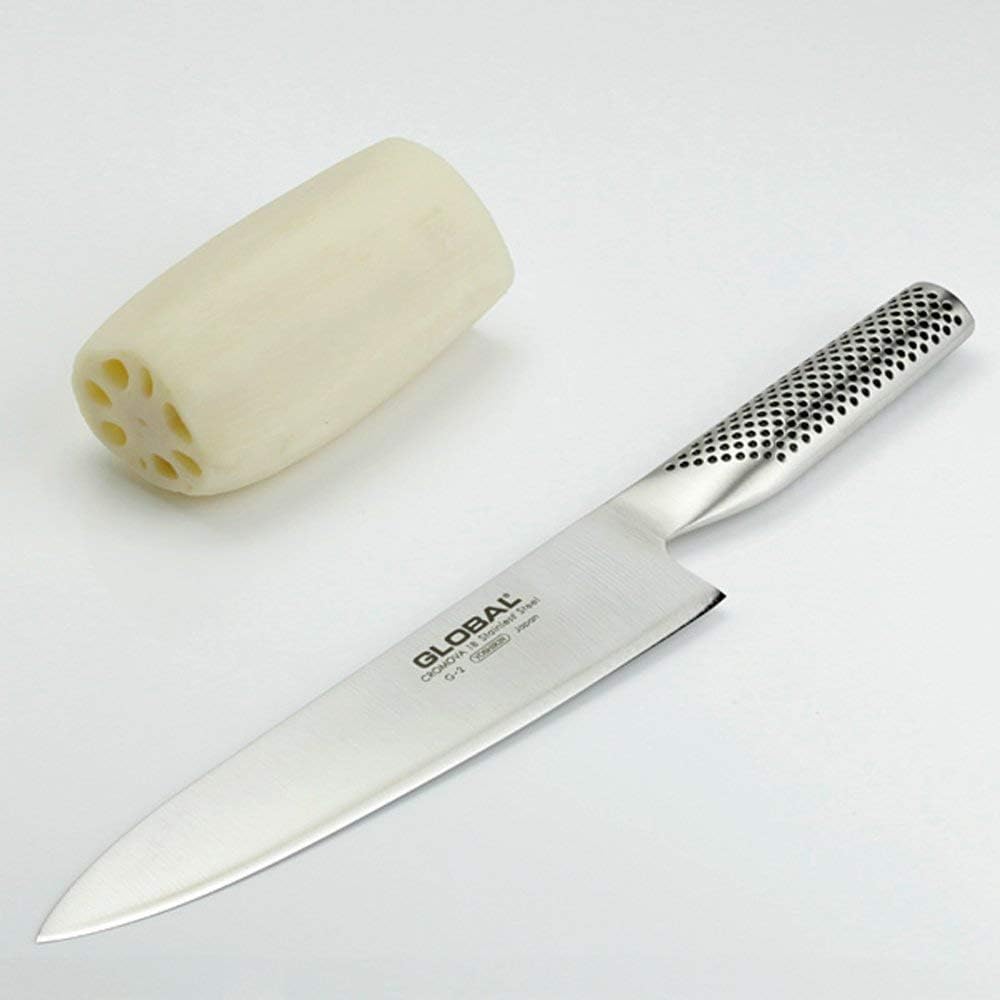
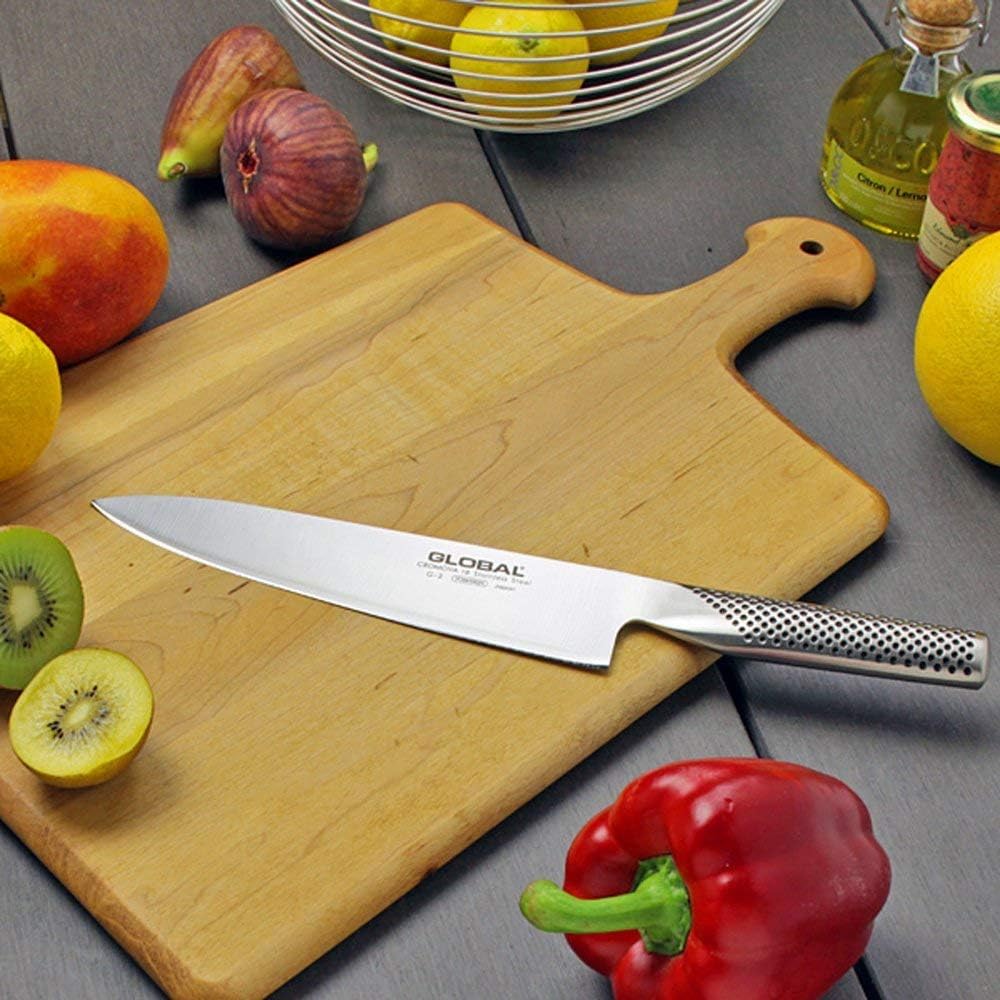
The iconic Global G-2 chef’s knife has been a staple in professional kitchens for decades. It is known for its unique one-piece construction and distinctive dimpled handle. Its all-stainless construction offers a different approach to Japanese knife design.
What We Love:
- Proprietary CROMOVA 18 steel balances hardness with corrosion resistance
- Extremely lightweight (5.5 oz) design reduces fatigue during extended use
- One-piece construction eliminates seams where bacteria could collect
- Excellent edge retention with easy home maintenance
- Perfectly balanced with the distinctive dimpled handle
Considerations:
- The all-metal handle can be polarizing—some love it, others find it uncomfortable.
- It may feel too light for cooks accustomed to heavier Western knives
- The softer steel (56-58 HRC) requires more frequent honing than harder Japanese options
Best For: Cooks who value lightweight design, professional chefs requiring extended cutting sessions, or those who appreciate minimalist aesthetics and easy cleaning.
5. MAC Superior – Best Compact Option
Price Range: $75-90
The MAC Superior series has developed a cult following among professional chefs for its exceptional cutting performance and manageable size. At 6.5 inches, it’s slightly shorter than standard chef’s knives, making it perfect for those with smaller hands or limited workspace.
What We Love:
- High-carbon steel with excellent 59-60 HRC hardness
- Incredibly sharp factory edge that maintains its performance
- Perfect balance between blade and comfortable pakkawood handle
- The thin blade excels at precision tasks and vegetable work
- Slightly shorter length offers better control for many users
Considerations:
- 6.5″ blade may be too short for some cutting tasks
- A thin blade requires careful use to prevent chipping
- Limited availability compared to more mainstream brands
Best For: Cooks with smaller hands, those with limited counter space, or anyone who prioritizes precision cutting over heft and power.
Additional Excellent Options
6. Shun Sora
Price Range: $90-99
Shun’s entry-level Sora line offers access to this prestigious brand at a fraction of its typical price. The composite blade features a VG10 cutting core with a Japanese 3-layer construction that delivers impressive performance.
7. Yoshihiro VG-10
Price Range: $95-99
Just barely making our under-$100 threshold, the Yoshihiro VG-10 represents exceptional traditional craftsmanship with its 3-layer construction, beautiful mahogany handle, and precision-oriented design.
8. DALSTRONG Phantom Series
Price Range: $70-80
The DALSTRONG Phantom offers excellent value with its AUS-8 Japanese steel, gorgeous pakkawood handle, and impressive fit and finish. It’s slightly softer than some alternatives but offers excellent durability.
9. Misono Molybdenum
Price Range: $90-99
This authentic Japanese-made knife features excellent molybdenum high-carbon steel and a traditional Western-style handle. It offers precision cutting with familiar ergonomics.
10. Findking Dynasty Series
Price Range: $60-70
For those attracted to Damascus patterns, the Findking Dynasty offers genuine 67-layer Damascus construction with a VG10 core at a surprisingly accessible price point.
Understanding Japanese Knife Types
Japanese knives come in various specialized forms, each designed for specific tasks. When shopping under $100, you’ll most commonly encounter these types:
Gyuto (Chef’s Knife)
The Japanese equivalent of a Western chef’s knife, the gyuto is versatile and suitable for most kitchen tasks. With a thinner blade than its Western counterpart, it excels at precise cuts while maintaining all-purpose functionality.
Santoku (Three-Purpose Knife)
Slightly shorter than a gyuto, the santoku excels at chopping, dicing, and mincing with its wide blade and sheep’s foot tip. It’s often lighter and more maneuverable for everyday tasks.
Bunka (Multipurpose Knife)
Similar to the santoku but with a distinctive K-tip point, the bunka offers precise detail work capabilities while maintaining general-purpose utility.
Nakiri (Vegetable Knife)
With a squared-off tip and thin blade, the nakiri is designed specifically for vegetable preparation. It delivers clean, precise cuts without crushing delicate ingredients.
Essential Factors in Choosing a Japanese Knife Under $100
Steel Type and Quality
Japanese knives typically use high-carbon steel variants. At under $100, look for:
- VG10: Premium option with excellent edge retention (rare at this price point)
- AUS-8: Good balance of sharpness and durability
- Molybdenum steel: Offers good corrosion resistance
- High-carbon stainless: Balances hardness with maintenance requirements
Handle Design
Japanese handles come in two primary styles:
- Wa-handle: Traditional round or octagonal handles (less common under $100)
- Yo-handle: Western-style handles that feel familiar to most users
Materials matter too. In this price range, look for:
- Pakkawood: Composite material offering durability and water-resistance
- Micarta/G10: Synthetic materials with excellent durability
- Wood composites: More affordable than solid wood but still attractive
Edge Type
Most Japanese knives under $100 feature:
- Double-beveled edges: Sharpened on both sides for versatility and ease of use
- 50/50 symmetry: Equal grinding on both sides for balanced cutting
Some specialty knives might offer:
- 70/30 asymmetric edges: Favoring right-handed users for more precise cuts
Blade Hardness (HRC)
Rockwell hardness indicates how hard—and potentially sharp—the steel is:
- 56-58 HRC: More forgiving, easier to sharpen, less brittle
- 59-61 HRC: Excellent balance of sharpness and durability
- 62+ HRC: Superior edge retention but potentially more brittle
Blade Profile
Consider how the knife will feel in your hand:
- Flatter profiles: Better for push-cutting techniques
- More belly: Better for rock-chopping methods
Caring for Your Japanese Knife
To maximize the lifespan of your investment:
Proper Washing
- Hand wash only—never put Japanese knives in the dishwasher
- Wash immediately after use, especially after cutting acidic foods
- Dry thoroughly after washing to prevent corrosion
Cutting Surface
- Use wood or soft plastic cutting boards only
- Avoid glass, marble, granite, or ceramic surfaces that can damage the edge
Sharpening
- Use whetstones rather than pull-through sharpeners
- Start with 1000 grit for regular maintenance
- Consider professional sharpening for higher-end options
Storage
- Use blade guards if storing in drawers
- Magnetic strips or wooden blocks are ideal storage solutions
- Never store loose items in a utensil drawer
Frequently Asked Questions
How do Japanese knives differ from German knives?
Japanese knives typically feature thinner blades with harder steel (58-65 HRC) than German knives (54-58 HRC). They excel at precision cutting but may be more brittle, while German knives offer more durability and heft for demanding tasks.
Can I get a “real” Japanese knife for under $100?
Absolutely! While ultra-premium handcrafted Japanese knives cost hundreds or thousands of dollars, many reputable Japanese manufacturers offer excellent entry-level options under $100 that incorporate traditional Japanese design and steel properties.
How often should I sharpen my Japanese knife?
With proper use, most Japanese knives under $100 should maintain good performance for 2-3 months before requiring sharpening. Regular honing with a ceramic rod can significantly extend this period.
Are Japanese knives high-maintenance?
They require slightly more care than standard Western knives but aren’t overly demanding. The primary requirements are hand washing, proper storage, and using appropriate cutting surfaces.
Can beginners use Japanese knives?
Yes! Models like the Fuji Narihira or Mercer Kanekoma offer excellent introductions to Japanese knives, which have more forgiving characteristics while still delivering superior performance to standard Western options.
Final Thoughts: Best Japanese Chef Knives Under $100
Finding a quality Japanese chef’s knife under $100 no longer compromises performance. Our top recommendation, the Tojiro DP Gyuto, delivers performance comparable to knives costing twice as much, with its VG10 core and excellent construction.
The Mercer Culinary Kanekoma is difficult to beat for the absolute best value. It offers surprisingly good performance at an entry-level price. For beginners just exploring Japanese cutlery, the Fuji Cutlery Narihira provides an excellent balance of performance and forgiveness.
Whichever knife you choose from our list, you’ll be experiencing authentic Japanese cutting performance without breaking the bank. These affordable options serve as excellent entry points into Japanese cutlery or as reliable daily drivers for experienced cooks who appreciate quality without the premium price tag.
Remember: Even an affordable Japanese knife deserves proper care and maintenance. With attention, these sub-$100 knives can deliver years of superior cutting performance and elevate your cooking experience.

